|
   |
|
Page 3 |
Newsletter 137 Summer 2022 © Hampshire Mills Group |
|
Longbridge Mill
Ruth Andrews and Ivor New
Photos by Ruth Andrews
|
|

|
|
Ruth: Having been unused for 2 years during the
Covid pandemic, Longbridge Mill is suffering from an
excess of reeds and nettles in its tailrace. HMG is
hoping to resume milling but at present the water
level backs up so much that the wheel cannot turn
freely. During the winter the vegetation has died
down – particularly the nettles! – so we have an
opportunity to do something about it. This project,
which all has to be
undertaken within specific agreed guidelines,
is progressing well but it has already taken several
days spread over several weeks, starting in March.
It has involved an ever-increasing number of
volunteers, always with Ivor New directing
operations; so far the cast list has consisted of
Andy, Eleanor, Mick, Fred, Ian, Rick, Ruth, Keith,
and Michael.
|
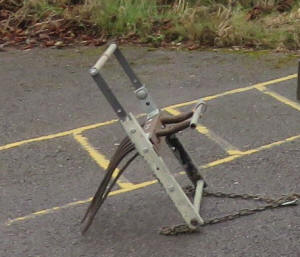 |
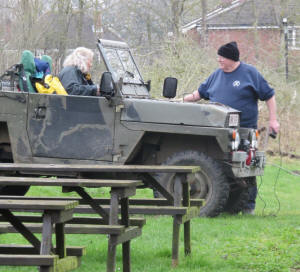 |
|
Ivor has designed a wonderful dredging tool – a
large rake – which is pulled by a newly purchased
winch attached to his elderly Land Rover.
The rake digs into the clumps of reeds, uproots
them, and pulls the whole mass towards the bank
without disturbing too much silt. Unfortunately it
requires Ivor (in a full dry suit) to guide the rake
while his helpers stand around on the bank operating
the Land Rover and winch, and trying to pretend that
they are being useful.
|
z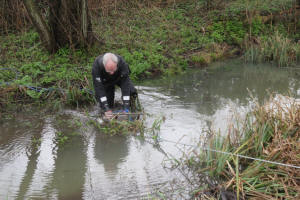 |
 |
 |
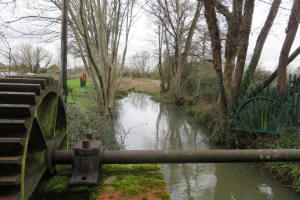 |
|
The
trick is to stop the winch before Ivor falls off and
the rake hits the bank. He then has to extract the
rake so that the load of reeds land on the bank (and
not back in the tailrace!). As you can see opposite
there is still a lot more vegetation to clear.
|
 |
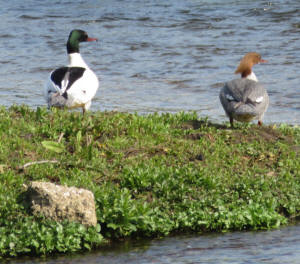 |
This pair of goosanders are often on the island in
the middle of the River Loddon, and there are plenty
of swifts, swallows, or house martins darting about
over the surface of the river hunting for insects;
there are also wagtails which have been known to
nest in the mill. |
|
Ivor: Wednesday 20 April: While Ruth continued
with the task of tidying and cleaning the mill
following the two years of inactivity, Andy and I
worked on the wheel, assuring ourselves that there
was nothing seriously amiss that would stop the
wheel turning. Although it was clear that the wheel
was seriously out of balance, due to much of it
being dry for a long time. It was also noted that
many of the starts were loose and would need wedges
adjusted or replaced. Additionally some of the
‘sole boards’ and starts have decorated badly and
need replacing, the sole boards with old float
boards and the starts with new ones which I’ll have
to make. Some work was done using the wedges
available. Limited work was also done to try and
find a simple way to easily control the wheel’s
rotational position while maintenance was
undertaken, unfortunately with little success. The
wheel was allowed to run and while the work done to
date on the tailrace has greatly improved matters it
is clear that the biggest blockage is now near its
confluence with the river.
|
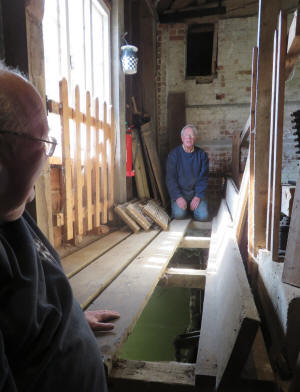
Andy and Ivor had to remove the plank on the walkway
between the headrace and the wheel so that they
could rescue the thin piece of plank that Andy had
just dropped down an inviting gap – just at the
moment when both Ivor and I had said “Mind it
doesn’t … “! If you look carefully, you can just
see the hydraulic sluice which was installed when
the mill was rebuilt after the fire.
|
The next day, Eleanor, her brother Rick, and Ian,
and I successfully cleared a channel through the
blockage at the confluence with the river, helped by
a full flow of water as we had the wheel turning.
There is still some tidying up to be done as most of
the blockage was willow boughs that were rooting in
the silt. These were temporally left on the bank
and still need removing. The water flow is now
greater than it has been for ages but there is still
a long section that needs to have reed removed to
increase the width of the channel.
Ian worked with the pub’s manager during lockdown,
clearing scrub. He went home to get his waders and
performed miracles with Ivor and Rick with loppers,
saws, and secateurs. They cleared fallen trees,
some of which had re-rooted, suckers, scrub, and all
the rubbish which had washed downstream.
|
|
Ruth: Wednesday 27 April: An even larger band of
workers assembled at Longbridge: Ivor, Eleanor,
Mick, and I were joined by Keith, Michael, Ian, and
Fred. So we were able to split into groups and
tackle several jobs. Fred and Ivor went inside the
wheel to continue working on it, but I didn’t take a
picture of them. Ian, Keith, and Michael cleared
the end of the tailrace where it meets the river,
and cut back many overhanging branches, piling
everything on the bank well back from the water. |
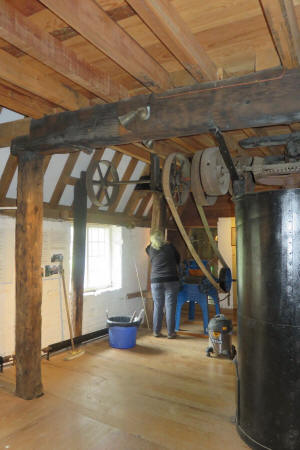
Eleanor and Ruth have been removing 2 years’ worth
of cobwebs, birds’ nests, and so on |
|
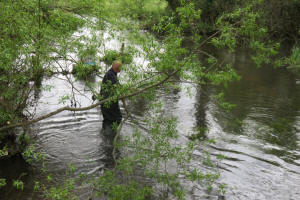
|
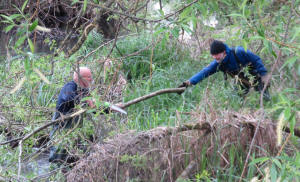 |
|
Mick, Ivor, Fred, and Ruth dismantled the furniture
of the millstone which is usually used for milling,
so that it could be cleaned.
Fred and Ivor used the stones crane to lift the tun,
and then the runner stone; it was covered in meal
moth larvae which had to be vacuumed off.
After a very late lunch, we ran the wheel, while
Ivor showed Ian and Michael around the mill.
We still have more work to do.
|
 |
|
|
